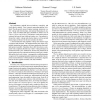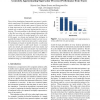54 search results - page 2 / 11 » An Instruction Throughput Model of Superscalar Processors |
ISCA
1997
IEEE
13 years 9 months ago
1997
IEEE
The performance tradeoff between hardware complexity and clock speed is studied. First, a generic superscalar pipeline is defined. Then the specific areas of register renaming, ...
IEEEPACT
2005
IEEE
13 years 11 months ago
2005
IEEE
In this paper we compare the performance of area equivalent small, medium, and large-scale multithreaded chip multiprocessors (CMTs) using throughput-oriented applications. We use...
HPCA
1999
IEEE
13 years 9 months ago
1999
IEEE
Control independence has been put forward as a significant new source of instruction-level parallelism for future generation processors. However, its performance potential under p...
APCSAC
2005
IEEE
13 years 11 months ago
2005
IEEE
In order to enhance the performance of a computer, most modern processors use superscalar architecture and raise the clock frequency. Superscalar architecture can execute more than...
ISPASS
2009
IEEE
14 years 3 days ago
2009
IEEE
Trace-driven simulation of superscalar processors is particularly complicated. The dynamic nature of superscalar processors combined with the static nature of traces can lead to l...


